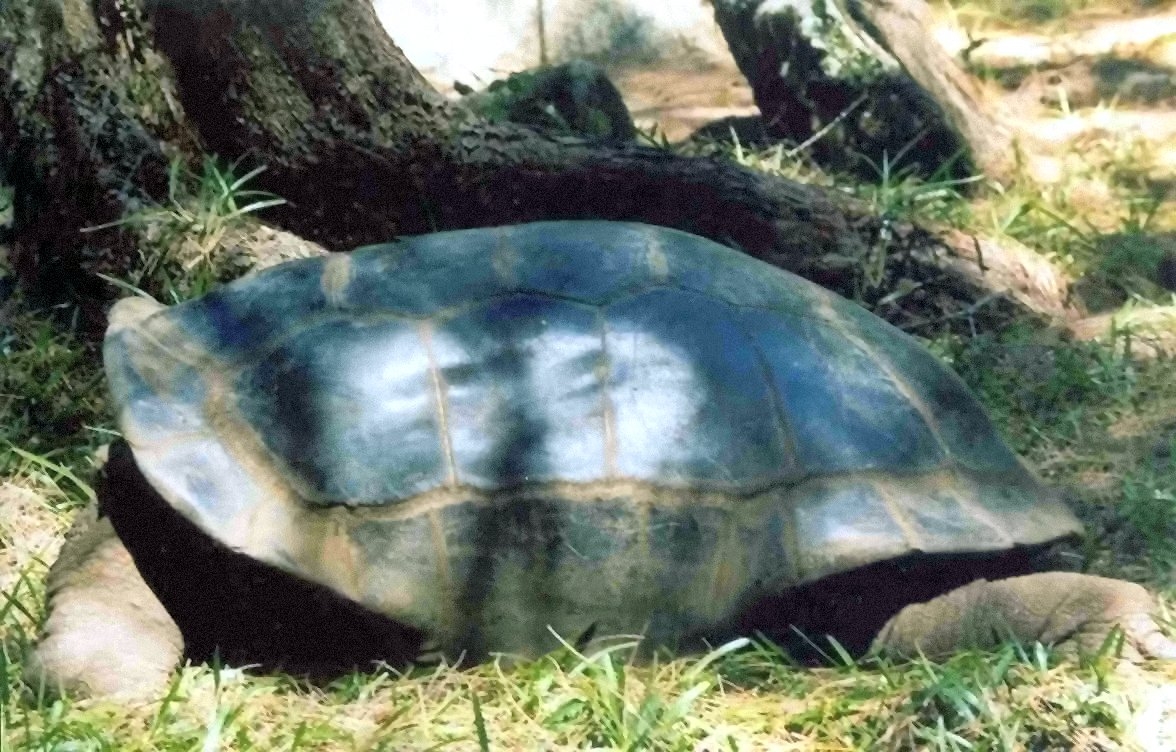- Arnold's Giant Tortoise
name = Arnold's Giant Tortoise
status = EW
status_system = iucn2.3
regnum =Animal ia
phylum =Chordata
classis = Sauropsida
ordo = Testudines
subordo =Cryptodira
familia =Testudinidae
genus = "Dipsochelys "
species = "D. arnoldi"
binomial = "Dipsochelys arnoldi"Arnold's Giant Tortoise ("Dipsochelys arnoldi") also known as the Seychelles saddle-backed tortoise inhabited the granitic
Seychelles islands until around 1840. At that time it was presumed to be extinct along with theSeychelles giant tortoise ; a species which shared the same islands.The report of oddly-shaped of tortoises in captivity in the mid-1990s prompted the Nature Protection Trust of Seychelles to investigate the identity of these captive tortoises. Examination of museum specimens of the 'extinct' Seychelles and Arnold species seemed to confirm that some living tortoises do show characteristics of the supposedly extinct species. However, some recently published scientific papers on the genetics of the Seychelles and Indian Ocean tortoises provide conflicting results. Some studies suggest that only one species was ever present in the islands whilst others suggest three distinct, but closely related species.
These different views derive from studies of different genes. A synthesis of all available genetic data indicates that Arnold's tortoise is genetically the most distinctive "Dipsochelys" tortoise. This fits with the ecology and morphology of the species, as a highly distinctive tortoise adapted to feeding on low vegetation rather than the grazing habits of the
Seychelles giant tortoise and Aldabra giant tortoise. Due to its unusual 'saddlebacked' shape, this is the only Seychelles tortoise species that regularly basks in the sun. The other species will do so occasionally, but Arnold's tortoises rapidly lose heat from the skin of their exposed necks and need to heat up in the sun in the mornings.A [http://members.aol.com/jstgerlach/tortoise.htm captive breeding programme] was established in 1997 and in December 2006 the five adult tortoises were returned to the wild on
Silhouette Island , forming the first wild population of this species since the early 1800s ( [http://members.aol.com/jstgerlach/report.pdf see report] ).Source
*cite journal |quotes=no |author=Jeremy J. Austin, E. Nicholas Arnaud & Roger Bour |year=2003 |title=Was there a second adaptive radiation of giant tortoises in the Indian Ocean? Using mitochondrial DNA to investigate speciation and biogeography of "Aldabrachelys" (Reptilia,Testudinidae) |journal=
Molecular Ecology |volume=12 |pages=1415–1424 |doi=10.1046/j.1365-294X.2003.01842.x |url=http://www.blackwell-synergy.com/doi/abs/10.1046/j.1365-294X.2003.01842.x |format=abstract page
*cite journal |quotes=no |author=Eric P. Palkovacs, Monique Marschner, Claudio Ciofi, Justin Gerlach & Adalgisa Caccone |year=2003 |title=Are the native giant tortoises from the Seychelles really extinct? A genetic perspective based on mtDNA and microsatellite data |journal=Molecular Ecology |volume=12 |pages=1403–1413 |doi=10.1046/j.1365-294X.2003.01834.x |url=http://www.blackwell-synergy.com/doi/abs/10.1046/j.1365-294X.2003.01834.x |format=abstract page
*Gerlach, J. & Bour, R. 2003 Morphology of hatchling giant tortoises. Radiata 12; 11-12
*Gerlach, J. 2004 [http://members.aol.com/jstgerlach/gtbook.htm Giant Tortoises of the Indian Ocean] . Chimiara publishers, Frankfurt
*Gerlach, J. 2005 Interpreting morphological and molecular data on Indian Ocean giant tortoises. In: Huber, B.A. et al. (Eds.) African Biodiversity: Morphology, Molecules and Systematics. Springer, New York
*Gerlach, J. 2004 Effects of diet on the systematic utility of the tortoise carapace. African Journal of Herpetology 53(1): 77-85.
*Gerlach, J. 2005 Thermoregulation in captive Indian Ocean giant tortoises. Chelonian Conservation & Biology 4; 937-941
Wikimedia Foundation. 2010.

